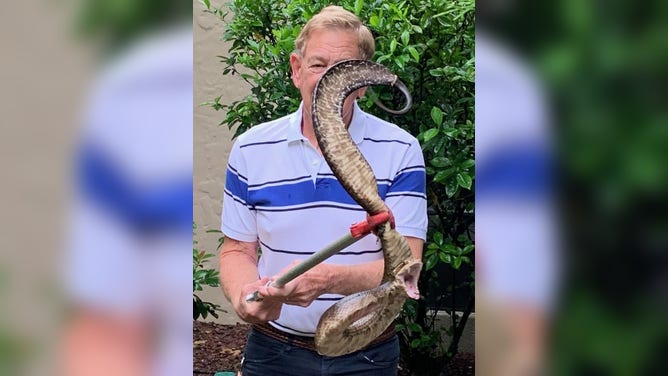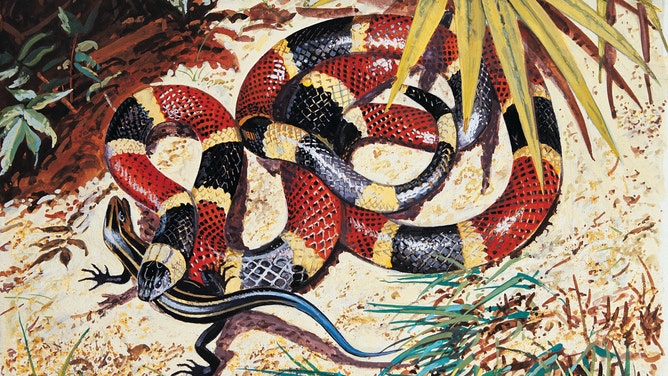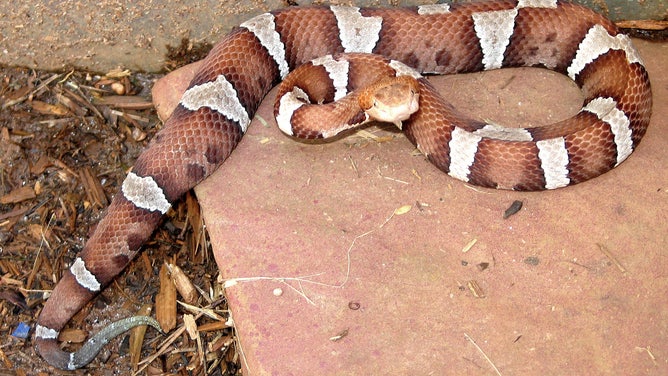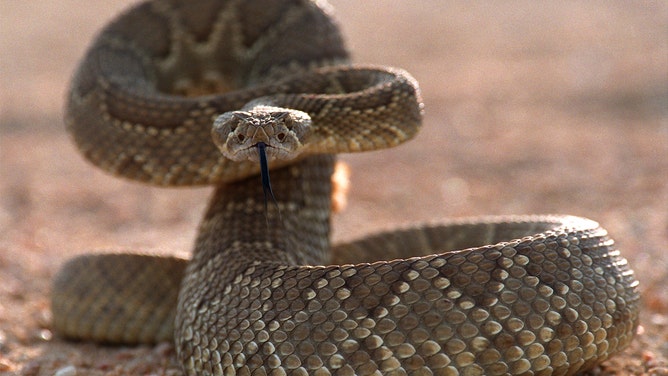Saving yourself or your pet's life from a snakebite
Venomous snakes live in 46 states, learn what to do if you are bitten to prevent permanent injury or death

A sidewinder rattlesnake poised to strike.
(Photo by Hulton Archive/Getty Images)
Most of us try to avoid snakes, but 7,000-8,000 Americans will be bitten by a venomous snake this year. Hiking on a trail, cleaning up around the yard or walking the dog across the grass at night all lead to an increased possibility of encountering one of these slithery reptiles.
And snakebites are more common now that it is mating season and the weather is getting warm. The good news is fewer than 0.01% of people die after being envenomated. The CDC reports that snake bites account for only five deaths a year in the U.S.
SNAKES ON THE MOVE: MATING SEASON AND WARMER WEATHER MAKE SERPENTS FRISKY
But, you do need to take action immediately if you, a companion or your pet is bitten by a rattlesnake, cottonmouth, copperhead or coral snake – the only four types of venomous snakes native to the U.S.
Toxic venom acts quickly and up to 44% of bite victims suffer permanent injury like the loss of use of a finger or an entire toe. The substance can destroy body tissue, prevent clotting and/or cause paralysis and respiratory failure.
How can you tell if a snake is venomous? In the U.S., these dangerous snakes either have colorful bands or have diamond-shaped heads and vertical eye slits. Many snakes look similar to non-venomous species though. The best rule of thumb is to call for help if you even think the snake may be venomous.
What to do if you are bitten
The CDC recommends:
- Back away from the snake. Don’t touch it and risk another bite. Whether coiled or not, snakes can accurately strike from a distance of one-third their body length. Even the fang from a dead snake or a severed snake head can still inject a dangerous venom, according to the American College of Medical Toxicology.
- Try to remember the color and shape of the snake or take a picture. Different snakebites require different antivenom. Snake identification is helpful but not essential.
- Call 9-1-1 or get your companion or pet medical attention immediately. Don’t drive yourself, snakebite victims can become dizzy and/or pass out. If you have to hike to get help, stay hydrated.
- Stay as calm and still as you can to slow the spread of the venom. While waiting for emergency responders, sit or lay down and keep the bite below the level of the heart. Wash the wound with warm soapy water. Remove any rings, watches and tight clothes before swelling starts. Cover the bite with a clean, dry dressing. If you can, mark the edge of the pain and swelling on the skin and write the time next to it to give medical providers an idea of how fast the venom is spreading.

Snake removal specialist Bob Cross holding his venomous catch, a 5 foot 9 inch cottonmouth. The Virginia Herpetological Society reports that the largest cottonmouth on record is 6 feet 2 inches long.
(Critter Capture Services)
What NOT to do if you are bitten
- Do not cut or slash the wound. Don’t suck the venom out. Don’t give the bite an electric shock. Those are myths that can make the injury worse.
- Don’t apply a tourniquet, press or squeeze. Don’t ice or soak it.
- Don’t drink alcohol for the pain. Don’t drink caffeine. Don’t take NSAIDs/anti-inflammatory medications like aspirin and ibuprofen. DO tell your doctor if you are on blood-thinners.
"Oh, you’ll, know if you get bitten by a venomous snake, it hurts like fire," said Bob Cross of Critter Capture Services of the time he was bitten by a pygmy rattlesnake. "He only got in with one fang, and it turned black and blue, and it felt like five hornets set there at one time on one finger. It burned."
Pets
Pets need immediate attention too if bitten. Over 100,000 dogs and 50,000 cats are bitten by venomous snakes each year reported the Morrison Animal Foundation and the American Society for the Prevention of Cruelty to Animals (ASPCA). Depending on the size of the pet up to 30% of the bites are fatal. Cats are twice as likely to survive, according to an Australian study.

A dog going through rattlesnake avoidance training.
(Mel Melcon/Los Angeles Times via Getty Images / Getty Images)
"You just have to come to the hospital because it's an intravenous treatment," said Carolyn Corkran, licensed vet technician. "It's treatable with antivenom, so you just have to get them to the emergency room."
What to do, the ASPCA recommends:
Carry your pet if possible to the car or walk, don’t run, to avoid spreading the venom. Any delay could mean more tissue damage. The ASPCA has a Poison Control Center for questions (888) 426-4435.
Symptoms
Some people don’t realize they were bitten by a snake especially in water or if the snake was hidden by brush. Symptoms vary depending on the species but the CDC suggests:
- Look for a pair of puncture wounds and redness, swelling, bruising and blistering around the bite. You will feel severe pain in the area.
- You may experience nausea, vomiting, or diarrhea. The toxins can cause a rapid heart rate, weak pulse and low blood pressure.
- Be aware of a metallic, mint or rubber taste in your mouth. You could have muscle twitching, numbness or tingling around your face or limbs and increased sweating and salivation.
- The venom can also alter vision and cause difficulty breathing. In the most serious cases, a person could stop breathing.

An 8 year-old Florida boy survived a juvenile cottonmouth snake bite on the thumb.
(Hilda M.Perez/Orlando Sentinel/Tribune News Service via Getty Images / Getty Images)
Medical professionals, many times treat animal and human victims with antivenom or antivenin. Scientists inject the venom into animals, often horses, which develop an immunity. The blood can be developed into antivenin stated Britannica.com.
Worldwide, about one million people are bitten by venomous snakes and 30-40,000 people die stated Encyclopedia Britannica.
Where are snakes
While snakes generally lurk in grasses and brush or sun themselves in the open, natural disasters like hurricanes, floods, drought and tornadoes may drive the reptile to places you don’t expect to see them.l



